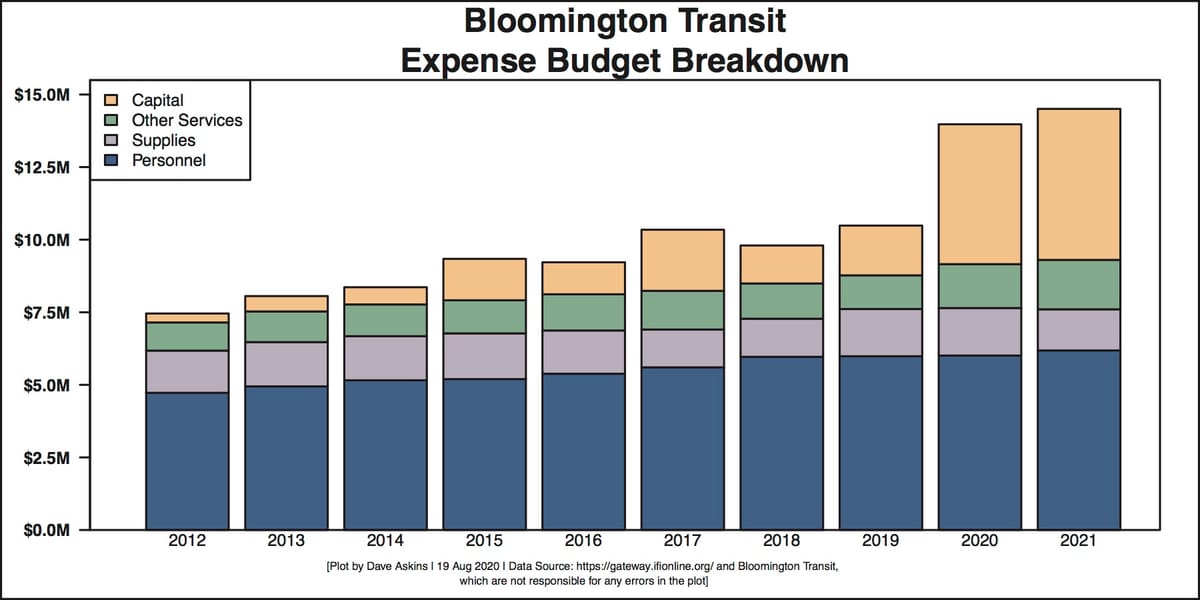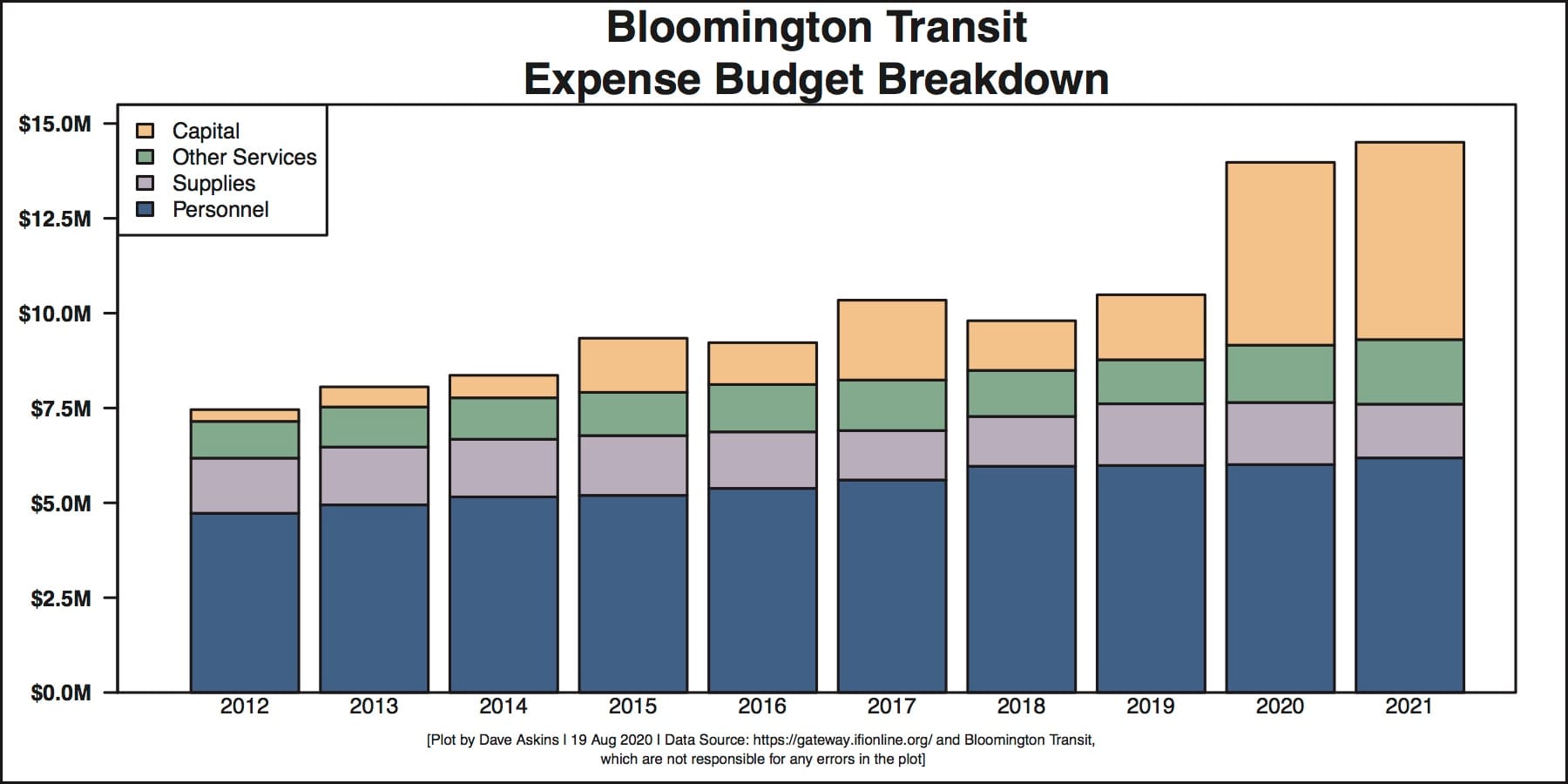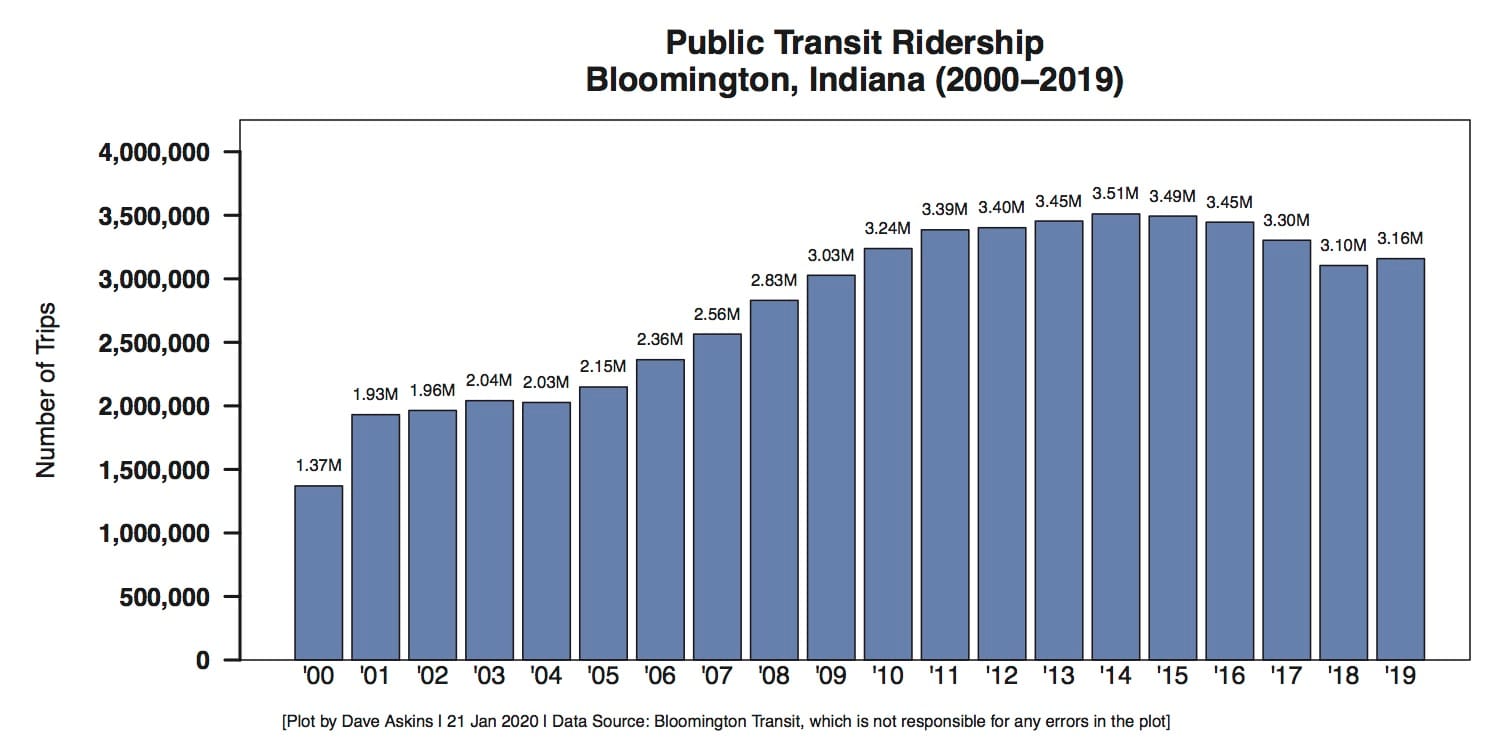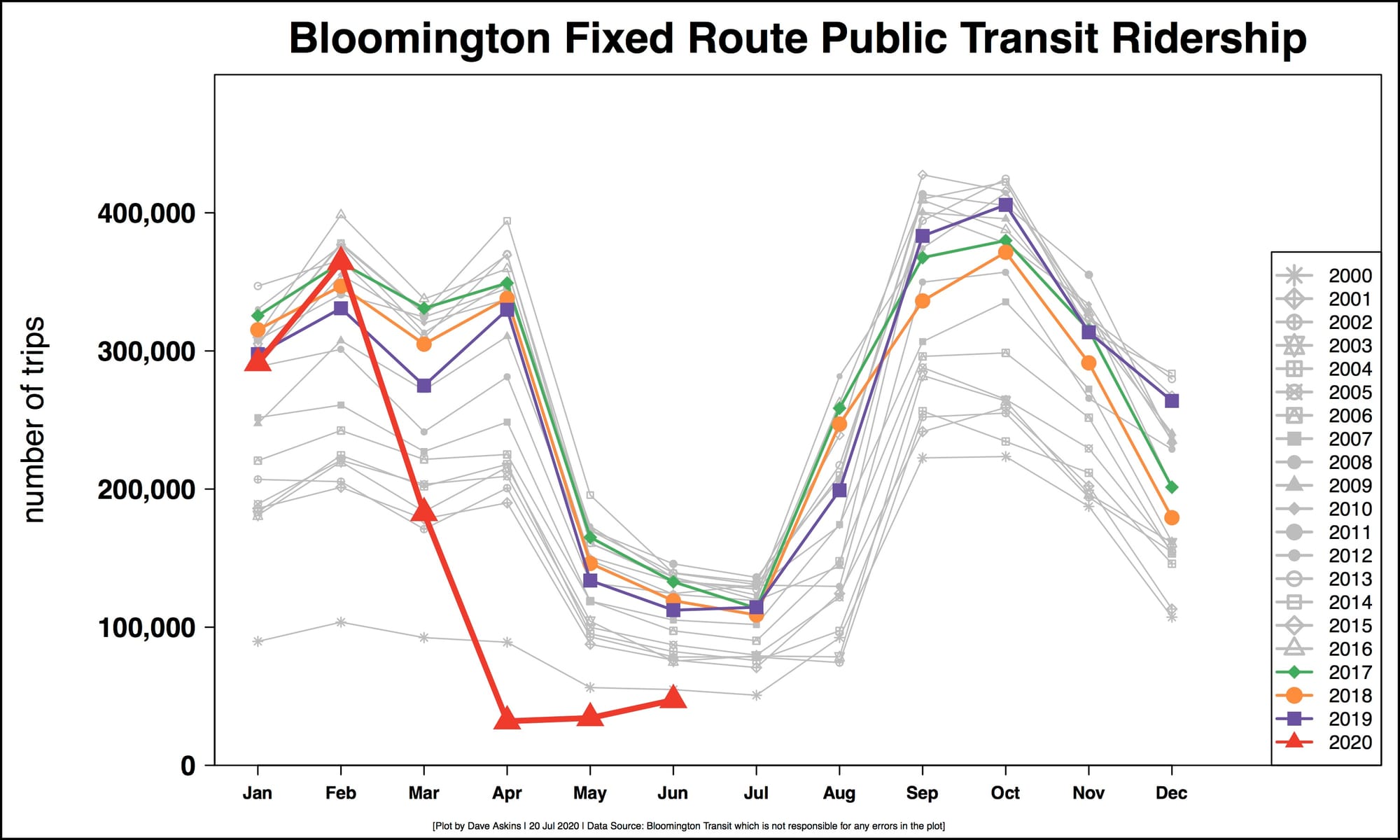Bloomington’s public transit looks to COVID-19 recovery in 2021




On Wednesday night, Bloomington Transit general manager Lew May presented his 22nd annual budget to Bloomington’s city council.
It was a part of the four-day series of 2021 budget presentations heard by the council this week. The council won’t see a final version of the budget until late September and won’t take a vote on it until October.
A highlight of BT’s 2021 budget is the way it maintains a course set in 2020, for the acquisition of electric buses. Three more are budgeted for next year. They show up in the capital expenditure breakdown of the $14.5 million total budget.
The planned 2021 capital expenditures are $5.2 million, which is about 8 percent more than last year’s $4.8 million. Compared to 2019, the 2020 capital expense figure was nearly double.
In the BT 2021 budget, one category that shows a decrease compared to the previous year is supplies—the amount decreases from $1.6 million to $1.4 million. That’s a drop of about 13.5 percent.
That decrease comes from BT’s ability to leverage the volume of its diesel fuel purchases, when combined with those of Indiana University’s bus system, to sign long-term contracts for several months, sometimes a year or more in advance, May told the city council.
The budgeted number for diesel fuel in 2020 was $2.43 per gallon, compared to $1.60 per gallon in the 2021 budget. That adds up to a savings of about $175,000, May said.
Personnel expenses are planned to increase by around 3 percent total. That includes a 1.5- to 2.5-percent increase for BT’s union workers, depending on the position, and a 2-percent increase for non-union workers. The 2-percent figure is the same as what’s been budgeted for city of Bloomington non-union employees.
A planned route optimization, originally scheduled for rollout around now, has been put off for implementation until 2021. This fall, May said, the BT board will be wrestling with the decisions on that.
Fare revenues this year will be considerably lower that budgeted, because BT has been operating fare-free for the last few months, during the COVID-19 pandemic. But the 2021 budget assumes the existing $1 fare per ride for fixed route service and the $2 for para-transit service.
Fares make up just 2.8 percent of BT revenues. Like most public transit systems, the majority of BT’s budget, about 73 percent of it, comes from federal and state assistance.
The topic of fares was one area of interest for Bloomington city councilmembers. That helped spotlight another topic: the connection between Bloomington’s public bus system and Indiana University.
The need for additional future revenue—to cover missing fares, or to expand transit service generally—got some limited air time at Wednesday’s meeting. It was in that context that a possible increase to the local income tax got a indirect mention.
Responding to a question during public commentary, May said that BT’s future plans for alternative fuel vehicles still allow for the possibility of a mix of compressed natural gas and battery-electric buses.
Fares: BT Access, Indiana University
For the last few months, and into the indefinite future, Bloomington Transit has been offering fare-free service. The initial practical consideration prompting the fare-free approach was that passengers were encouraged to board through the rear doors of buses—to reduce chances for driver-passenger COVID-19 transmission.
The fare boxes are located at the front door. If passengers are boarding through the rear doors, drivers can’t monitor fares or IDs for Indiana University affiliates, who normally board buses without paying a fare.
On Aug. 24, when Indiana University fall classes start, front-door boarding will resume, but drivers will be enclosed in plexiglass partitions, so the fare-free approach will continue.
At Wednesday’s hearing, councilmember Kate Rosenbarger asked BT general manager Lew May if there were any plans to adopt a fare-free approach, even after the COVID-19 pandemic.
May pointed to a couple of considerations. One is the federal ADA requirement to offer para-transit service (BT Access) to the disability community, at no more than twice the price of a fare on a fixed route bus.
That means if regular fixed-route bus service were fare-free, BT Access would also need to be fare-free, May said. The cost for every BT Access trip is somewhere between $15 and $20 for every trip, May said. The current $2 fare controls the demand for the service, May said. If the $2 fare were eliminated, it could allow for unchecked demand. That could lead to a considerable total cost increase, May said.
An additional consideration, May said, is the annual contribution that Indiana University makes to BT, to cover the fares of its students, faculty and staff. “The university is contributing over $1 million to pay for student fares, and they’re contributing more than $100,000 to pay for employee fares. If we go fare-free, we would need the university to continue that contribution,” May said.
About 70 percent of Bloomington Transit rides are taken by Indiana University affiliates.
Responding to a question from Rosenbarger, May said that the amount of IU’s contribution to cover rides of its affiliates, is still being negotiated for the coming year.
Until the details can be worked out, while ridership levels for the fall are still uncertain, BT and IU are using an interim agreement.
“The university wants to see how many students are going to be returning and they won’t know that number until next week. So we’ve agreed to postpone negotiations until they have a better handle on the final number of students that that show up,” May said.
Fares: Local Income Tax Increase
The other part of May’s response to Rosenbarger’s question, about adopting a fare-free approach in a post-COVID-19 world, was to point to a need for additional funding.
May said, “Over the years, there’s been a lot of discussion about that, especially at council budget meetings just like this one. We’re very open to the possibility of going fare-free. All we need is for somebody to step to the plate and provide the funding to replace the funding that we would lose.”
Some of the people who could “step to the plate” are city councilmembers. They could vote to increase the local income tax (LIT), along the lines proposed by Bloomington’s mayor, John Hamilton, on New Year’s Day. Expanded transit was one of the anti-climate-change initiatives that Hamilton wants to fund with the increased income tax.
Hamilton has recently reduced the suggested amount of increase that he thinks the city council should consider—from 0.5 to 0.25 percentage points. The amount generated inside the city of Bloomington by the additional quarter point on the LIT would be around $4 million, with another $4 million other jurisdictions in Monroe County.
In his presentation, May said, “There have been discussions in the past year about the possibility of a climate LIT, …a portion of which could be used for expanding public transit service in our community.”
May added, “I know those conversations have taken a backseat in response with the onset of the pandemic, but we’re hoping that those conversations will resume at some point and that there’ll be some serious consideration given to using a climate LIT to possibly expand public transportation and grow it and improve service in our community.”
Since mid-July, when Hamilton renewed his call for a LIT increase, Bloomington city councilmembers have not taken up a LIT increase as a topic of discussion at any of their public meetings.
The only mention of a LIT increase at a public meeting of the city council came on Aug. 5, during deliberations on a $2 million appropriation ordinance. Hamilton had asked the council to approve the appropriation as a part of his “Recover Forward” initiative.
On that occasion, councilmember Jim Sims said, “I am really, really excited that there is no additional request at this time for citizen investments, tax investments, at this time.”
Electric vs. Compressed Natural Gas
At Wednesday’s budget hearing, May said that compressed natural gas (CNG) as a bus fuel is still in the mix as a possibility, even though BT is purchasing battery-electric buses in the meantime. “We have not ruled CNG out.”
May pointed to a study that City of Bloomington Utilities (CBU) is doing on the possibility of installing an anaerobic digester at the Dillman wastewater treatment plant.
The CBU 2021 budget presentation (scheduled for Thursday) includes a description of the anaerobic digester project: “During 2019 and 2020, Mayor Hamilton tasked CBU with leading a Waste-to-Energy initiative, working with other City departments, the Monroe County Solid Waste Management District, IU, and others to evaluate the potential for an anaerobic digestion facility that could derive natural gas from wastewater sludge, organic solid waste, food service waste, and other ‘high-strength’ wastewater streams.”
In January this year, CBU director Vic Kelson gave the city council an update on the project. In his presentation, Kelson said an anaerobic digester to capture natural gas would be a $30–35 million project.
The debt service for such a project would be around $2 million a year, Kelson said. The city spends around $800,000 a year on vehicle fuel. The anaerobic digester might be able to replace one-third of that, Kelson said.
So the conclusion CBU has reached is that just the savings in operations costs won’t be enough to pay for the project. There are a number of “wild cards,” Kelson added. Among those wild cards is the possibility that energy credits could be established for such a project and that those credits could be sold by CBU.
At Wednesday’s budget hearing, May said if it makes financial sense, there’s no reason why BT couldn’t have a mix of CNG and battery electric buses. The most challenging factor would be the availability of physical space at BT’s Grimes Lane headquarters. A CNG fueling station would take up a significant amount of space, May said, and might require acquisition of adjacent property.
Acquiring adjacent property might be necessary, even for the expansion of the electric bus fleet, May said. “We’re going to need space for charging stations,” he said.
Connected to the acquisition of electric buses, another project in the 2021 budget is an engineering assessment of BT’s electrical infrastructure at the Grimes Lane headquarters. An important element of infrastructure assessment will be evaluating the potential for solar panels for charging of battery electric buses, May said.




Comments ()